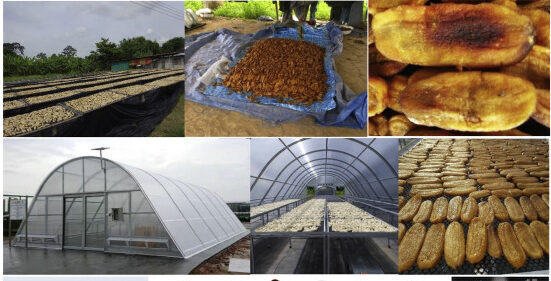Introduction of Sun dryer Principle
- In the fast-paced modern world, we often forget the wisdom of our ancestors when it comes to preserving food.
- Before refrigeration and canning became commonplace, our forebearers relied on age-old techniques like sun drying to preserve the bounty of harvest for leaner times.
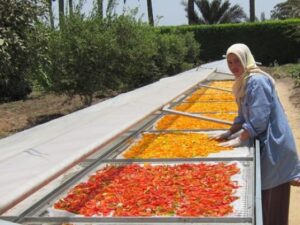
- There are many food drying methods discussed in the previous post using solar and hot air with a heater. Today, as people seek more sustainable and natural ways of living, the art of sun drying is making a remarkable comeback.
- In this blog post, we’ll explore the traditional method of sun drying for food preservation, its benefits, and how you can incorporate this ancient technique into your modern homestead.
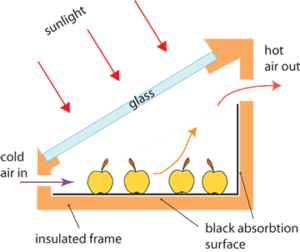
Solar Drying Techniques
- Solar drying, also known as sun drying or solar dehydration, is a method of food preservation that utilizes the energy from the sun to remove moisture from food items.
- This process helps prevent spoilage, extend shelf life, and maintain the nutritional content of the dried food.
- There are several techniques of solar drying, each designed to optimize the drying process for different types of food items and environmental conditions.
- Here are some common techniques of solar drying:
Direct Sun Drying
- This is the simplest and most common solar drying technique.
- Food items are spread out in a single layer on clean and sanitized surfaces, such as drying racks, mats, trays, or clean ground.
- The food is directly exposed to sunlight, and natural convection and airflow help remove moisture from the food.
- This technique is suitable for fruits, vegetables, herbs, and some types of meat.
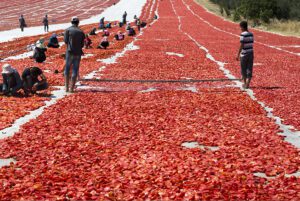
Indirect Sun Drying
- Indirect solar drying involves using solar energy to heat the air, which then passes over the food to remove moisture.
- In this technique, the food is placed in a solar dryer or cabinet with a transparent cover, such as glass or plastic.
- The solar dryer traps the sun’s heat, creating a warm and dry environment for drying the food.
- This method is particularly useful in areas with high humidity or during unpredictable weather conditions.
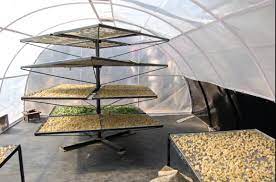
Solar Dehydrator
- A solar dehydrator is a more sophisticated version of indirect sun drying.
- It is a box-like structure with a transparent cover, black interior, and vents for airflow.

- The solar dehydrator absorbs and traps heat, creating a controlled environment for drying food efficiently and evenly.
- Some solar dehydrators have multiple trays, allowing for larger quantities of food to be dried at once.

Solar Tunnel Dryer
- A solar tunnel dryer is a long, narrow structure with a transparent top and dark-colored walls.
- The food is placed on trays or racks inside the tunnel, and the sun’s heat is absorbed by the walls, raising the temperature inside the tunnel for drying. This technique is suitable for large-scale drying of grains, fruits, and vegetables.

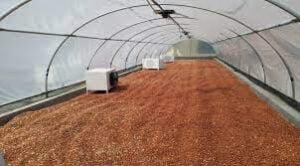
Solar Cabinet Dryer
- A solar cabinet dryer is a smaller, enclosed structure with a transparent front cover and black interior walls.
- It is suitable for drying smaller quantities of food items and is often used for herbs, spices, and small fruits.
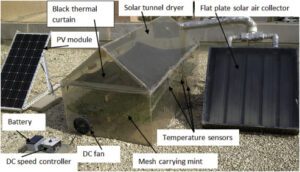
Mixed-Mode Drying:
- Some solar dryers combine solar energy with other energy sources, such as electricity or biomass, to ensure continuous and consistent drying, even during periods of limited sunlight.
- Regardless of the solar drying technique used, it is essential to ensure proper hygiene, protection from pests, and regular turning or stirring of the food during the drying process to achieve uniform drying and prevent spoilage. The drying time varies depending on the type of food, its moisture content, and the weather conditions, so patience and attention to detail are key to successful solar drying.
- Sun drying is an age-old method of preserving fruits, vegetables, herbs, and even certain types of meat and fish.
- It harnesses the energy of the sun to remove moisture from food items, thereby preventing the growth of harmful microorganisms and enzymes that lead to spoilage. The simplicity of sun drying lies in its minimal requirements: sunlight, airflow, and time.
- Unlike other food preservation techniques that involve energy-intensive processes, sun drying is a sustainable and eco-friendly way to store your harvest.
Major Benefits of Sun Drying
Nutrient Retention:
-
- Sun drying retains many of the natural nutrients found in fresh produce, making it a healthier alternative to commercially processed foods.
No Artificial Additives:
-
- Sun drying doesn’t require any additives or preservatives, keeping your food free from chemicals commonly found in store-bought dried products.
Reduced Energy Consumption:
- Unlike electric dehydrators or freeze-drying methods, sun drying utilizes free and abundant solar energy, reducing your carbon footprint.
Minimal Investment:
-
- Sun drying doesn’t necessitate expensive equipment; it can be achieved with basic tools like screens, trays, or even homemade drying racks.
Connection to Nature:
-
- Engaging in the sun-drying process connects us to nature’s rhythms, fostering a deeper appreciation for the environment and its resources.
Sun Drying Process:
- Selecting the Right Produce: Choose fresh, ripe, and blemish-free fruits, vegetables, or herbs for drying. Slice them into uniform pieces to ensure even drying.
- Preparing for Drying: Depending on the produce, you might need to blanch, dip in lemon juice, or apply light salting before placing them in the sun.
- Drying Location: Find a sunny spot with good airflow for the drying process. Traditionally, people use drying racks or lay the produce on clean mats or screens.
- Time and Patience: Sun drying is a gradual process, and the time required varies with weather conditions. Be patient and allow nature to take its course.
- Testing for Dryness: Regularly check the food for dryness by feeling and inspecting it. Properly dried food should be leathery or brittle with no signs of moisture.
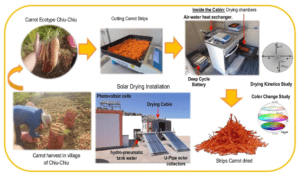
What food can be Sun-Dried?
- Once your food is fully dried, transfer it to clean, airtight containers or sealable bags. Store the containers in a cool, dry, and dark place to maintain the quality of the sun-dried goodies. Consume them within a few months to enjoy the best flavor and nutritional benefits.
- Sun drying is a versatile method of food preservation that can be used for a wide variety of food items. Here are some of the most common types of foods that can be sun-dried:
Dry Fruits
-
- Sun drying is a popular method for preserving fruits like apricots, peaches, plums, apples, grapes, figs, and berries.
- Dried fruits are not only delicious but also packed with natural sugars and nutrients.
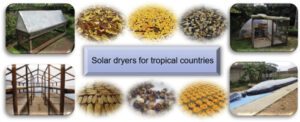
Vegetables:
- Many vegetables can be sun-dried to create tasty and nutritious snacks or ingredients for later use.
- Some common examples include tomatoes, peppers, carrots, peas, beans, and onions.
Herbs:
- Sun drying is an excellent way to preserve the flavors of fresh herbs. Herbs like basil, mint, oregano, thyme, and rosemary can be dried and used in culinary applications throughout the year.
Nuts
- Nuts such as almonds, walnuts, pecans, and cashews can be sun-dried to enhance their shelf life and concentrate their flavors.
Grains:
- Certain grains like corn, rice, and quinoa can be sun-dried for storage and later use in various recipes.
Meat:
In some regions, meat and fish are sun-dried to preserve them for long periods. Thin strips of meat or fish are exposed to the sun until they become dry and have a jerky-like texture.
Seeds:
- Seeds like pumpkin seeds and sunflower seeds can be dried in the sun for snacking or as toppings for various dishes.
Chilies:
- Sun-drying chilies is a common practice to preserve their spiciness and flavor for use in cooking.
Tea Leaves:
- Some tea leaves are sun-dried to enhance their aroma and flavor before packaging.
- It’s essential to note that the time required for sun drying varies depending on the type and size of the food, as well as the weather conditions.
- Additionally, some foods may require pre-treatment (such as blanching or dipping in lemon juice) to ensure better preservation and prevent spoilage during the drying process.
Sundry of Food Grains
- Sun drying grains is a traditional and effective method of preserving them for long-term storage. Grains such as corn, rice, wheat, and millet can be sun dried to reduce their moisture content, preventing spoilage and insect infestation. Here’s a step-by-step guide on how to sun dry grains:
- Harvesting: Ensure that the grains are fully mature and dry in the field before harvesting. Avoid harvesting grains when they are damp or contain high moisture content.
- Cleaning: Thoroughly clean the grains to remove any chaff, dirt, or debris. You can use a winnowing basket or a clean cloth to separate the grains from impurities.
- Spread Thinly: After cleaning, spread the grains in a thin layer on a clean and dry surface. Traditionally, people use mats, clean sheets, or large trays for sun drying.
- Sun Exposure: Place the grains in direct sunlight, preferably in an open area with good airflow. Ensure that the grains receive ample sunlight throughout the day.
- Frequent Turning: To promote even drying, regularly turn and mix the grains using a clean and sanitized tool. This helps prevent mold or fungal growth.
- Testing for Dryness: Sun-drying grains can take several days, depending on the weather conditions and the moisture content of the grains. To check for dryness, take a handful of grains and squeeze them. If they break easily without leaving any indentation, they are adequately dried.
- Overnight Storage: If the weather becomes humid or dew forms in the evening, bring the grains indoors or cover them with a clean cloth to protect them from moisture.
- Storing Dried Grains: Once the grains are thoroughly dried, store them in airtight containers made of glass, metal, or food-grade plastic. Keep the containers in a cool, dry, and dark place to maintain the quality of the dried grains.
Tips for Sun Drying Grains:
- Avoid sun-drying grains during rainy or high-humidity days, as the grains may reabsorb moisture and spoil.
- Insects can be a concern during sun drying. To prevent infestation, you can freeze the grains for a few days before sun drying, or place bay leaves or neem leaves among the grains during drying and storage.
- Large-scale grain drying may require the use of specialized drying racks or solar dryers to ensure consistent and efficient drying.
Solar drying of biomass
- Solar drying of biomass is a sustainable and energy-efficient method of reducing moisture content in organic materials like agricultural residues, wood, and other forms of biomass.
- By harnessing the sun’s energy, this process allows for the efficient preservation and use of biomass for various applications, including fuel, feedstock, and organic matter for composting.
- Solar drying of biomass is particularly relevant in areas where access to other drying methods, such as mechanical dryers or ovens, may be limited or impractical. Here’s an overview of the solar drying process for biomass:
- Biomass Selection: Choose appropriate biomass materials for drying, such as agricultural residues (e.g., crop straws, husks, or shells), wood chips, sawdust, or any other organic matter that requires moisture reduction.
- Preparation: Prepare the biomass by shredding or chipping it into smaller pieces. This increases the surface area, facilitating quicker drying.
- Drying Surface: Select a suitable drying surface or structure to hold the biomass. Depending on the quantity, you can use clean, flat ground or construct raised drying beds, trays, or racks. Ensure the drying surface is clean and free from contaminants.
- Spreading the Biomass: Spread the biomass evenly on the drying surface in a thin layer. Avoid stacking or piling the biomass to promote even drying and proper airflow.
- Solar Dryer Construction: For more controlled and efficient drying, consider building a solar dryer specifically designed for biomass. A solar dryer typically consists of a transparent cover to trap solar heat, dark-colored surfaces to absorb heat, and vents for airflow.
- Solar Exposure: Place the biomass in direct sunlight to maximize solar heat absorption. The heat from the sun will gradually remove the moisture from the biomass.
- Airflow: Adequate airflow is essential for effective solar drying. Ensure that the drying area has good ventilation to allow moist air to escape and be replaced with dry air.
- Drying Time: The drying time depends on various factors, including the type of biomass, its initial moisture content, the weather conditions, and the drying method used. Biomass may take several days to weeks to reach the desired moisture level.
- Covering at Night: If the drying process extends over multiple days, consider covering the biomass at night to prevent moisture reabsorption due to dew or high humidity.
- Testing for Dryness: Periodically check the moisture content of the biomass using a moisture meter or by simple physical examination. The biomass is adequately dried when its moisture content reaches the desired level for storage or further processing.
- Solar drying of biomass offers a cost-effective and eco-friendly solution for reducing moisture content, making biomass more suitable for storage, transportation, and utilization in various applications. By using solar energy to dry biomass, communities can increase their self-reliance, reduce waste, and promote sustainable practices for managing organic materials
Conclusion:
- Sun-drying grains is an age-old practice that not only preserves the harvest but also helps retain the nutritional value of the grains. By following proper hygiene and storage practices, you can successfully sun dry grains and have a ready supply of staple foods for your household.
- Sun drying is a delightful way to reconnect with our ancestral roots while embracing sustainable living.
- The simple yet effective technique offers a plethora of benefits, from retaining nutrients to reducing energy consumption.
- By sun drying our harvest, we can savor the taste of summer’s abundance throughout the year and reduce food waste. So, let’s revive the art of sun drying and bask in the flavors of nature’s gift, all while treading gently on our planet.
